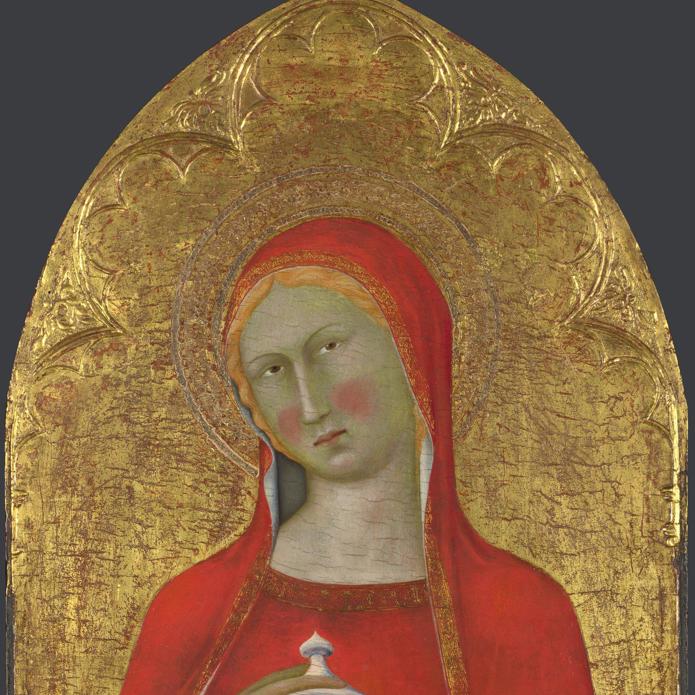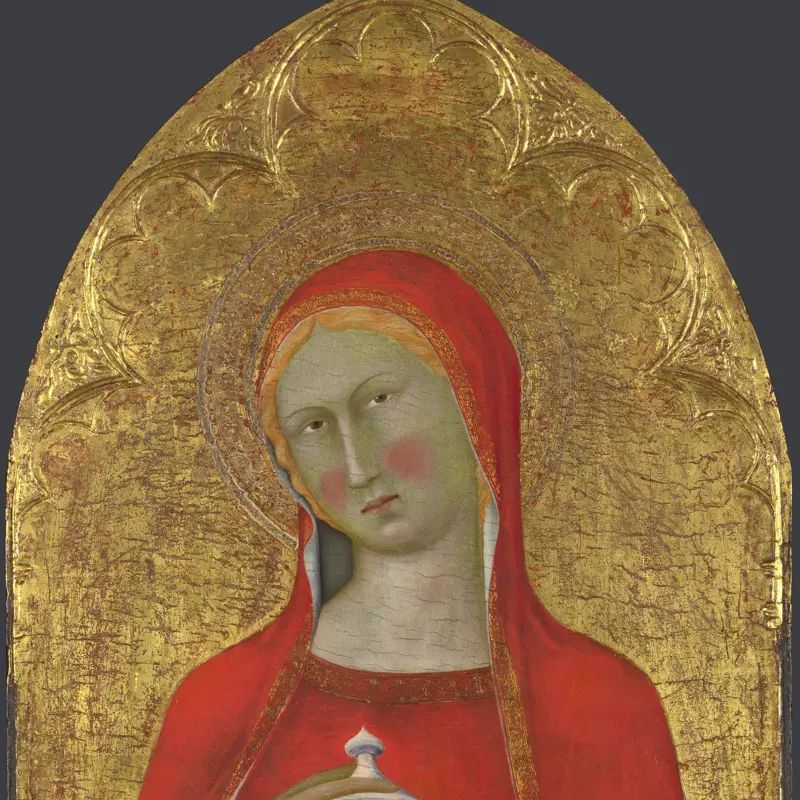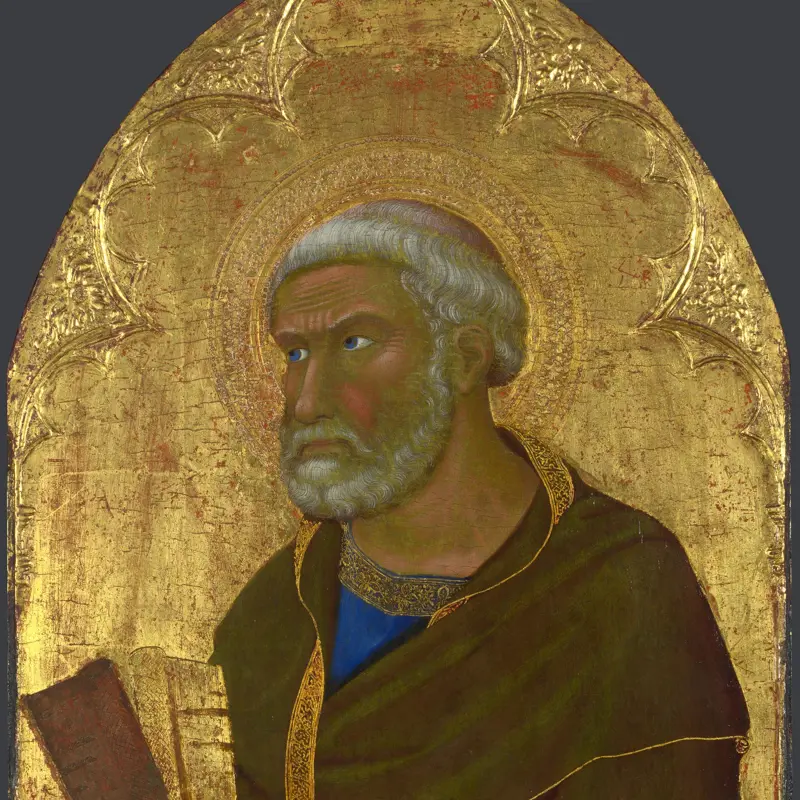Master of the Palazzo Venezia Madonna, 'Saint Mary Magdalene', about 1350 (?)
About the work
Overview
The saint depicted here is Mary Magdalene, identifiable by the ointment jar she holds and by her robes of bright scarlet, a colour traditionally associated with her.
Saint Mary Magdalene was linked with the Mary of the Gospels, who Christ allowed to wash his feet when he was dining with his followers (John 12: 1–8). She was also the first person to whom Christ appeared after his resurrection. She had gone to his tomb with ointment, planning to anoint his body, but found it empty. Instead she saw Christ, and mistook him for a gardener (John 20: 1–18).
The artist has taken great care to paint the ointment jar so that it resembles white marble with pink and blue veins. Its surface has a soft luminosity, an effect achieved by painting a thin layer of white paint over a base of layer of bright colours. This technique is known as scumbling.
Key facts
Details
- Full title
- Saint Mary Magdalene
- Artist dates
- Active mid-14th century
- Part of the series
- Master of Palazzo Venezia Altarpiece Panels
- Date made
- About 1350 (?)
- Medium and support
- Egg tempera on wood (probably poplar)
- Dimensions
- 60.1 × 34.5 cm
- Acquisition credit
- Presented by the Misses Cumming in memory of their father, Charles D. Cumming, 1930
- Inventory number
- NG4491
- Location
- Not on display
- Collection
- Main Collection
Provenance
Additional information
Text extracted from the ‘Provenance’ section of the catalogue entry in Dillian Gordon, ‘National Gallery Catalogues: The Italian Paintings before 1400’, London 2011; for further information, see the full catalogue entry.
Exhibition history
-
2011Devotion by Design: Italian Altarpieces before 1500The National Gallery (London)6 July 2011 - 2 October 2011
Bibliography
-
1909B. Berenson, The Central Italian Painters of the Renaissance, 2nd edn, New York 1909
-
1937E.S. Vavalà, 'Some Partial Reconstructions 1', The Burlington Magazine, LXXI/415, 1937
-
1947A. Santangelo, Museo di Palazzo Venezi: Catalogo: 1. Dipinti, Rome 1947
-
1951Davies, Martin, National Gallery Catalogues: The Earlier Italian Schools, London 1951
-
1955N. Di Carpegna, Catalogo della Galleria Nazionale, Palazzo Barberini, Roma, Rome 1955
-
1961M. Davies, The Earlier Italian Schools, 2nd edn, London 1961
-
1974Cleveland Museum of Art, European Paintings before 1500, Cleveland 1974
-
1981E. Carli, La pittura senese del Trecento, Milan 1981
-
1983M. Lonjon, L'Art gothique siennois (exh. cat. Musée du Petit Palais, Avignon, 26 June - 2 October 1983), Avignon 1983
-
1986Davies, Martin, National Gallery Catalogues: The Earlier Italian Schools, revised edn, London 1986
-
1988Gordon, Dillian, National Gallery Catalogues: The Early Italian Schools before 1400, revised edn, London 1988
-
1996E.W. Rowlands, The Collections of the Nelson-Atkins Museum of Art. Italian Paintings 1300-1800, Kansas City 1996
-
2001
C. Baker and T. Henry, The National Gallery: Complete Illustrated Catalogue, London 2001
-
2011Gordon, Dillian, National Gallery Catalogues: The Italian Paintings before 1400, London 2011
About this record
If you know more about this work or have spotted an error, please contact us. Please note that exhibition histories are listed from 2009 onwards. Bibliographies may not be complete; more comprehensive information is available in the National Gallery Library.
Images
About the series: Master of Palazzo Venezia Altarpiece Panels

Overview
These panels, which show Saints Mary Magdalene and Peter, were once part of the main tier of an altarpiece. The central image was of the Virgin and Child (now in the Palazzo Barberini, Rome) and two images of saints appeared on individual panels on either side.
Our two paintings were both to the right of the image of the Virgin, with Saint Peter probably closest to it. Another showing Saint Paul (now in a private collection) was probably situated directly to the left of the central image. Our panels were at one stage converted into rectangles – the current arched tops are modern additions, attached before the panels entered our collection to restore them to their original shape.
Silver has been detected on the back of the panels in other collections. We don't know the altarpiece’s original location, but if it did have a silver back then it’s likely that it was not designed to be placed against a wall.


